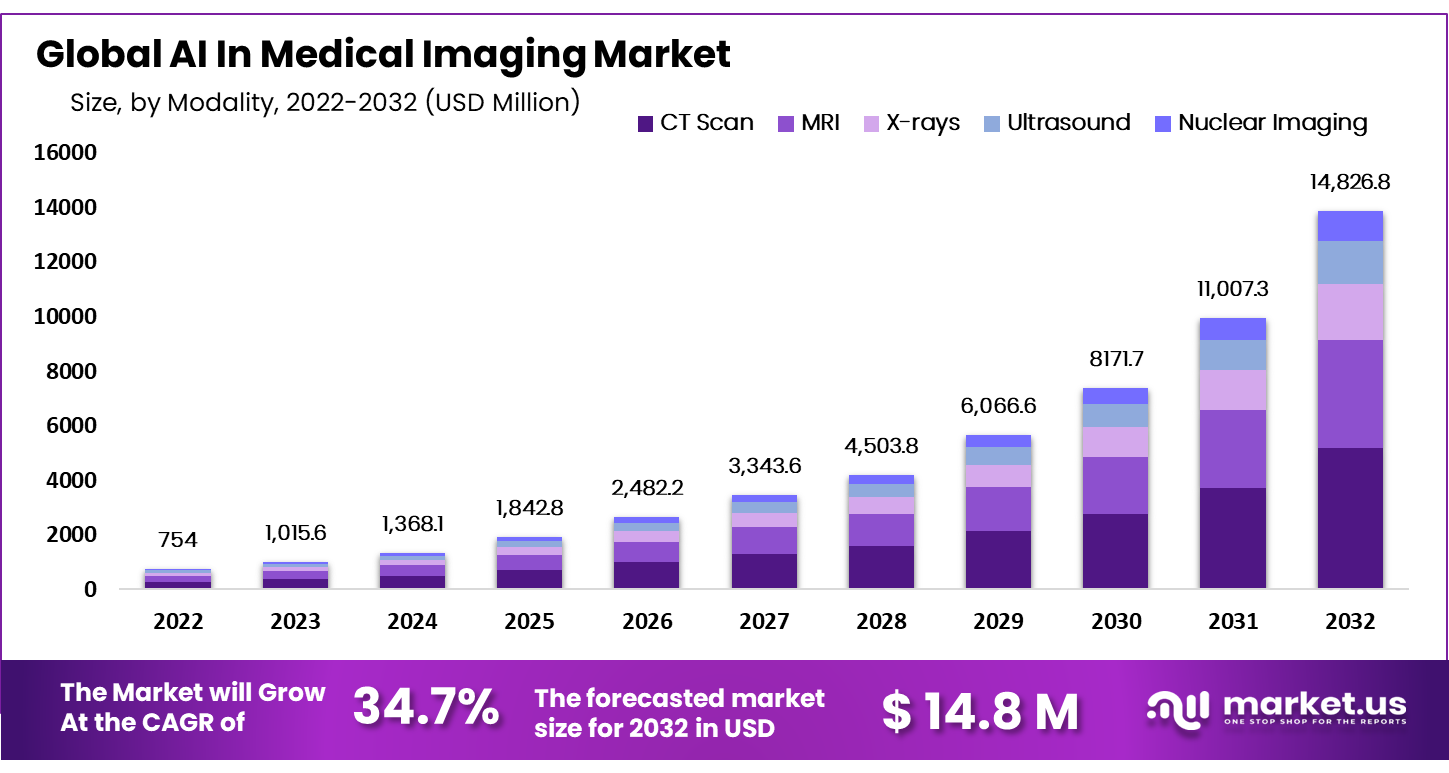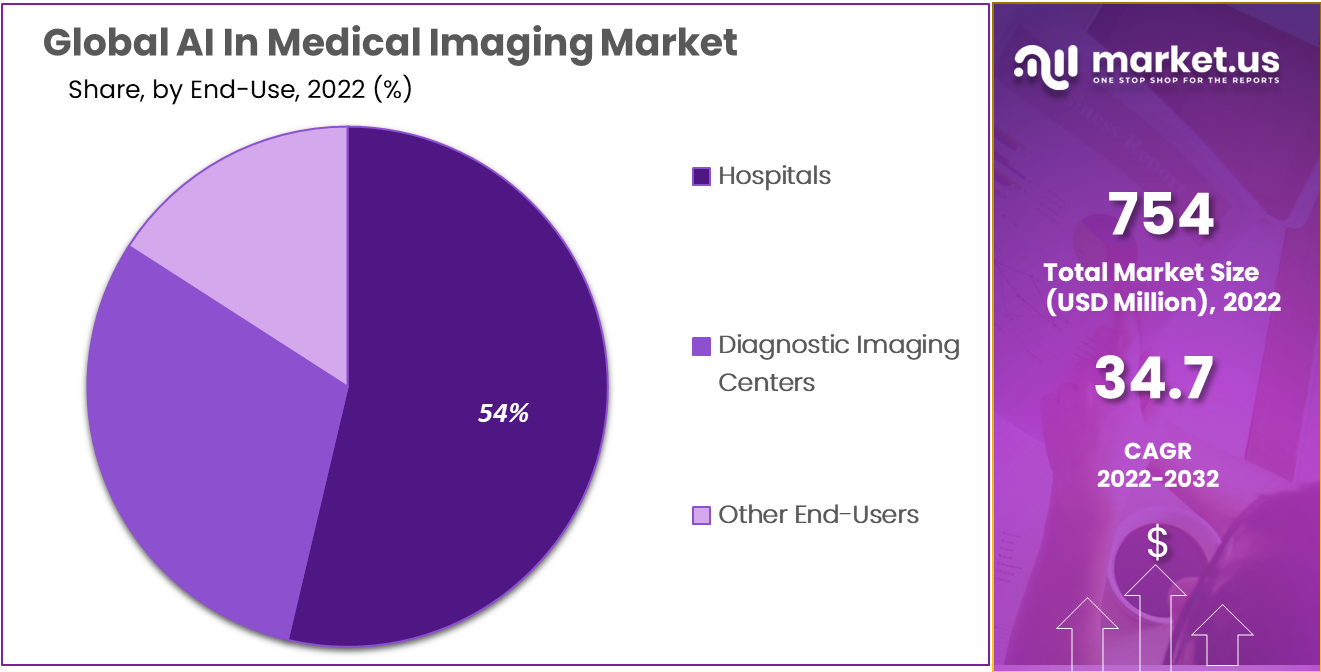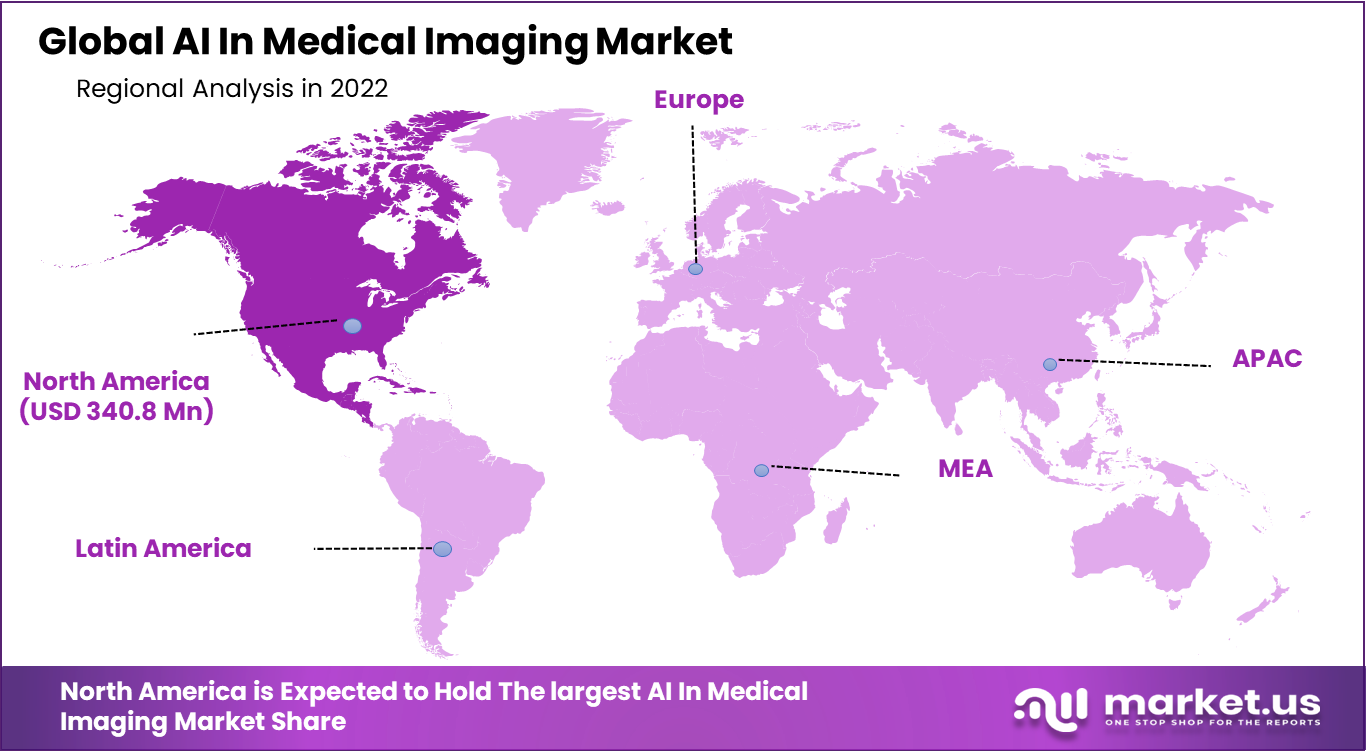New York, Sept. 25, 2023 (GLOBE NEWSWIRE) -- According to a recent report by Market.us, the Global AI In Medical Imaging Market size is expected to be worth around USD 14,826.8 Million by 2032 from USD 754 Million in 2022, growing at a CAGR of 34.7 % during the forecast period from 2023 to 2032.
Artificial intelligence is a rapidly evolving technology with a variety of applications. It can also be used to improve the quality of procedures such as medical imaging. AI in medical imaging refers to the use of artificial intelligence algorithms for analyzing medical images like X- rays, C T scans, MRI, and ultrasound images. AI can help in the diagnosis, detection, and monitoring of various diseases & conditions which includes heart disease, cancer, neurological disorders, and musculoskeletal disorders.
AI algorithms can be trained to identify & classify abnormalities in medical images like tumors, lesions, and fractures. This can help radiologists to make more accurate diagnoses & develop more effective treatment plans. Another application of AI in medical imaging is image segmentation. AI algorithms can be used to separate different structures within a medical image, such as organs or tissues, which can help plan surgical procedures or radiation therapy.

Market.us has identified key trends, drivers, and challenges in the market, which will help clients improve their strategies to stay ahead of their competitors. - View a PDF sample report @ https://market.us/report/ai-in-medical-imaging-market/request-sample/
Key Takeaway
- By employing artificial intelligence algorithms, the quality of medical imaging procedure can be inceased substantially. The use of AI can assist in detection and diagnosis of diseases along with formulation of treatment plans.
- AI can also help in segmenting of medical images, which offers deeper insights into an organ.
- Based on modality, the CT scan held a significant share of AI in the medical imaging market in 2022.
- Based on application, in 2022, AI in the medical imaging market was dominated by the neurology segment.
- By technology, the web-based segment was the most lucrative in the AI in the medical imaging market in 2022.
- Based on end-use, the hospital's segment dominated AI in the medical imaging market in the year 2022.
- North America was the largest contributor to the AI in the medical imaging market with a market share of 45.2%.
- APAC is expected to have the highest CAGR among all regions, owing to the region has large population & growing middle class.
Factors affecting the growth of the AI in Medical Imaging industry?
There are several factors that can have an impact on the growth of the AI in medical imaging industry including
- Investments in R&D: AI in Medical Imaging is a highly lucrative and innovative market, with promising prospects. This has prompted substantial investments from both government and privae sectors.
- Advancements in AI technology: With advancements in AI technology, the accuracy of AI in medical imaging is improving. AI algorithms can now detect subtle changes in medical images that may be missed by human radiologists.
- Shortage of radiologists: There is a shortage of radiologists worldwide, specifically in developing countries. AI can help in the automation of certain tasks like image analysis & reporting, reducing the workload of radiologists and enabling them to focus on more complex cases.
- Increasing demand for precision medicine: Precision medicine involves tailoring treatments to individual patients based on their specific needs. AI can assist in this process by analyzing medical images and providing insights into a patient's condition, enabling more personalized treatment plans.
- Government initiatives and funding: Governments around the world are investing in AI research and development, particularly in healthcare. This is driving innovation and growth in the AI in Medical Imaging industry.
- Integration with healthcare systems: As healthcare systems become more integrated & digitized, there is an increasing need for AI in medical imaging to help manage & analyze the large amounts of data generated by these systems.
Top Trends in AI in Medical Imaging Market
The AI in the medical image market is experiencing several new trends that are shaping the industry. First, employing natural language processing to analyse narrative reports by radiologists has become popular. In recent years, the research surrounding Natural Language processing has increased. Such reports are often unstructured and thus increase the friction in delivery of medical care. By using natural language processing models, clinicians are able to access the required data much more efficiently. Second, there is a growing focus on the integration of AI in medical imaging with other healthcare systems such as electronic health records and clinical decision support systems. This integration can improve the accuracy of medical diagnosis and allow for seamless sharing of data.
Thirdly, there's a trend toward the development of portable & handheld medical imaging devices that use AI algorithms to diagnose medical conditions faster & more accurately. AI is at the forefront for developing personalised treatment plans for patients. By implementing AI, medical images can be analyzed effectively. This can not only accelerate the process of delivering the most suitable medical treatment, but also augment the abilities of radiologists.
Regional Analysis
North America dominates the global AI market for medical imaging. North America is expected to have the largest revenue share of 45.2%. North America is expected to register CAGR of 34.9% during the forecast period. North America has a strong research and development infrastructure, especially in the field of medical imaging. North America is home to many of the world's leading research institutions & universities. North America's healthcare industry is large, which creates a large market for medical image technology. The region has a high level of healthcare spending, mainly due to increasing prevalence of chronic diseases, which allows healthcare providers in the region to invest in advanced imaging technologies.

To understand how our report can bring a difference to your business strategy, Inquire about a brochure at https://market.us/report/ai-in-medical-imaging-market/#inquiry
Scope of the Report
| Report Attributes | Details |
| Market Value (2022) | USD 754 Million |
| Market Size in 2032 | USD 14826.8 Million |
| CAGR (2023 to 2032) | 34.7% |
| North America Revenue Share | 45.2% |
| Historic Period | 2016 to 2021 |
| Base Year | 2022 |
| Forecast Year | 2023 to 2032 |
Market Drivers
AI in the Medical Imaging market is driven by several factors expected to contribute to the growth and development of this market. First, there is a growing demand for medical imaging solutions that are more accurate & effective. These solutions can provide faster diagnoses, reduce the need for invasive procedures, and improve patient outcomes. Second, the development & use of advanced AI algorithms like deep learning algorithms has allowed for the creation of more accurate & reliable medical imaging models. Thirdly, combining AI with medical imaging is expected to improve efficiency in healthcare delivery by automating routine tasks and reducing the workload of healthcare professionals. Fourthly, as electronic health records and digital healthcare systems become more prevalent, there are opportunities to integrate AI into medical imaging technology.
Market Restraints
The AI market in medical imaging faces several challenges that could impact its growth and development. First, the limited availability of high-quality data for training algorithms and the creation of accurate models can hamper the development of AI in the medical imaging market. Second, the high costs of developing & implementing AI-based medical imaging solutions could be a barrier to entry for certain companies & healthcare providers. Thirdly, a lack of standardization within the AI market for medical imaging can cause interoperability problems and hinder the seamless integration between AI technology and existing medical imaging systems. Fourthly, privacy and security concerns can also affect the adoption of AI for medical imaging. Patients & healthcare providers might be reluctant to share sensitive medical information. Finally, the regulatory environment for AI in Medical Imaging is still evolving. Uncertainty around regulations and compliance may create barriers to entry and growth.
Market Opportunities
While the use of AI is revolutionising the medical imaging industry, and in turn, the radiology industry; the technology will not be replacing human radiologists. Natural language processing models can be trained to provide a list of possible diagnosis when presented with the clinical data of patients by identifying underlaying patterns and analysing any peculiarities in the medical images. Additionally, the technology can be used to build a comprehensive and dynamic database that accrues knowledge over time. This has immense implications in medical imaging industry. Furthermore, AI can betrained to predict the possibility of developing diseases such as the Alzheimer’s. this can be done by training the program to detect any changes in the scans, and calculate the possibility of developing the disease along wth the time it takes. Not only this, but AI models can also be trained to annotate the images with observed anomalies, accompanied by detailed analyses of suitable treatment options.
Immediate Delivery Available | Buy This Premium Research Report @ https://market.us/purchase-report/?report_id=103306

Report Segmentation of the AI in Medical Imaging Market
Modality Insights
The CT scan segment dominates the global AI market for medical imaging with a market share of 37.4% and a CAGR of 34.8%. The higher standard of the image is responsible for many clinical outcomes. Both major and smaller suppliers offer a range of AI-based medical imaging solutions that can be used with the CT scan modality. The CT scan gives more detailed information than other methods. The small amounts of radiation used in CT scans are not harmful over the long term. The market is segmented into CT scans and MRIs.
Application Insight
The neurology segment is expected to dominate the global AI in the Medical Imaging market with a market share of 39.8% over the forecast period. The demand for early & precise diagnosis of diseases & neurological disorders such as Alzheimer's, Parkinson's, and Multiple Sclerosis. AI-powered medical imaging devices enable healthcare professionals to detect subtle changes in brain function & structure which may not be visible using traditional imaging techniques.
Technology Insights
With a substantial market share of 58.8%, deep learning is projected to dominate the AI medical imaging market. The CAGR for this segment is 34.4%. The deep learning segment is a prevailing segment in the AI Medical Imaging market. This can be attributed to its analysis capabilities which facilitate processing intricate datasets with great precision and speed. In addition, deep learning algorithms are able to independently extract data from medical images, allowing them to detect small differences & abnormalities which human observers and machine learning techniques may have missed.
End-Use Insights
Hospitals dominate the market with a market share of 53.7% and a CAGR of 34.6%. Hospitals are the primary healthcare providers and have access to a large number of medical image data, making them an ideal place to develop & test AI solutions. Hospitals have the infrastructure & resources to integrate AI-powered imaging tools into existing workflows. This allows them to provide more accurate & efficient diagnoses and treatment plans.
Recent Developments of the AI in Medical Imaging Market
- In July 2022, Philips Smartspeed AI was approved by the FDA, the US Federal Agency. This software offers high-quality MR images at a rapid speed. Addtionally, it facilitates a swifter and superior imaging process, even for the patients with implants.
- In June 2021, Perimeter Medical Imaging AI revealed that the business was successful in implementing a technology transfer of a manufacturing process. The institute partnered with Minnetronix Medical for the development of a novel optical-coherence tomography imaging system (OCT).
- In June 2021, the partnership between VUNO Inc. (South Korean AI organization) and Samsung Electronics was announced. This partnership aims to combine Samsung's GM85, a mobile digital X-ray device, with the VUNO Med-Chest, an X-ray powered by AI. VUNO expects to move closer to the global market with this partnership with Samsung.
Market.us has identified key trends, drivers, and challenges in the market, which will help clients improve their strategies to stay ahead of their competitors. - View a PDF sample report @ https://market.us/report/ai-in-medical-imaging-market/request-sample/
Market Segmentation
Based on Modality
- CT Scan
- MRI
- X-rays
- Ultrasound
- Nuclear Imaging
Based on Application
- Deep Learning
- Natural Language Processing (NLP)
- Other Technologies
Based on Technology
- Industrial
- Residential
- Commercial
Based on End-Use
- Hospitals
- Diagnostic Imaging Centers
- Other End-Users
By Geography
- North America
-
- The US
- Canada
- Mexico
- Western Europe
-
- Germany
- France
- The UK
- Spain
- Italy
- Portugal
- Ireland
- Austria
- Switzerland
- Benelux
- Nordic
- Rest of Western Europe
- Eastern Europe
-
- Russia
- Poland
- The Czech Republic
- Greece
- Rest of Eastern Europe
- APAC
- China
- Japan
- South Korea
- India
- Australia & New Zealand
- Indonesia
- Malaysia
- Philippines
- Singapore
- Thailand
- Vietnam
- Rest of APAC
- Latin America
-
- Brazil
- Colombia
- Chile
- Argentina
- Costa Rica
- Rest of Latin America
- Middle East & Africa
-
- Algeria
- Egypt
- Israel
- Kuwait
- Nigeria
- Saudi Arabia
- South Africa
- Turkey
- United Arab Emirates
- Rest of MEA
Competitive Landscape
Seeing that AI as well as medical imaging are both rapidly evolving industries, the AI in medical imaging market is highly competitive. Established as well as new players in the market are vying for the market leader position. As far as competitive landscape is considered, strategic alliances & product innovation are the focal points. Additionally, strategies such as mergers and acquisitions have also been adopted by key players to further cement their position in the market.
Listed below are some of the most important AI in Medical Imaging industry players.
Key Market Players
- General Electric Co.
- Siemens Healthineers Co.
- Koninklijke Philips Corporation
- IBM Watson
- Agfa-Gevaert Group/Agfa Health Care
- Arterys Inc.
- Azmed Co.
- Caption Health
- Gleamer
- Butterfly Network Inc.
- Other Key Players
Browse More Related Reports:
- Hyperspectral Imaging Market was valued at USD 14.9 Billion and it is projected to expand to USD 51.2 Billion by 2032
- Clinical Trial Imaging Market was valued at US$ 1,067.3 Million
- Diagnostics Imaging Market accounted for USD 33.0 billion and is expected to reach around USD 54.6 billion in 2032
- Veterinary Imaging Market size is expected to be worth around USD 3.3 Billion by 2032 from USD 1.8 Billion in 2022
- Medical Imaging Market size is expected to be worth around USD 48.8 Billion by 2032 from USD 29.2 Billion in 2022
About Us:
Market.US (Powered by Prudour Pvt Ltd) specializes in in-depth market research and analysis and has been proving its mettle as a consulting and customized market research company, apart from being a much sought-after syndicated market research report-providing firm. Market.US provides customization to suit any specific or unique requirement and tailor-makes reports as per request. We go beyond boundaries to take analytics, analysis, study, and outlook to newer heights and broader horizons.
Follow Us on LinkedIn | Facebook | Twitter
Our Blog:
